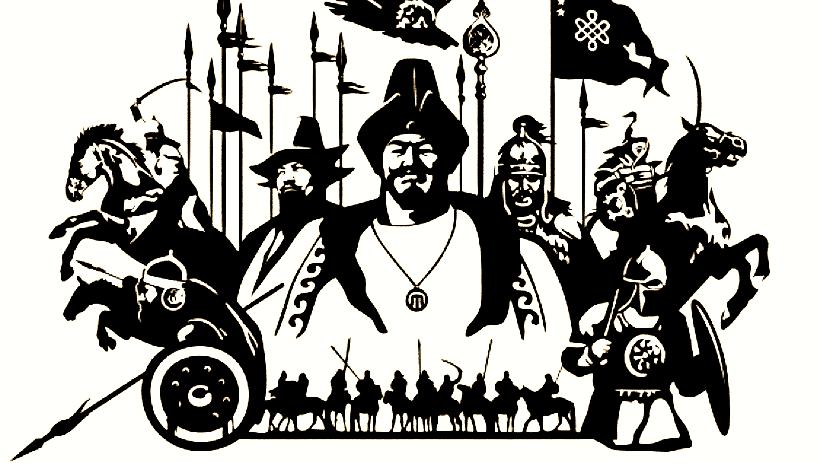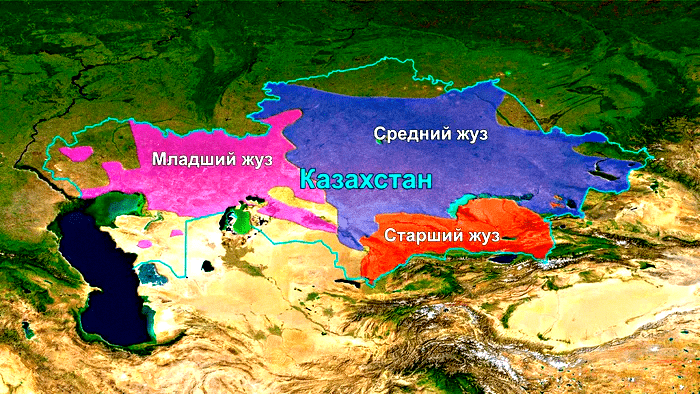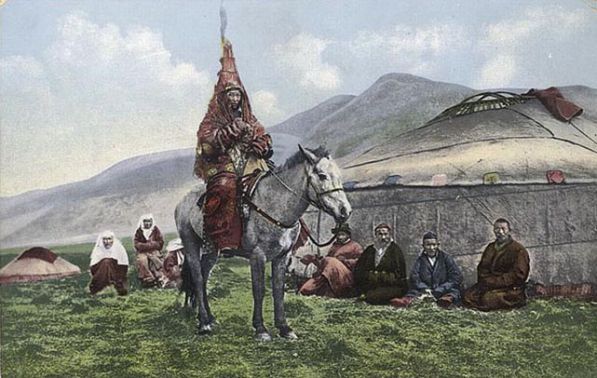Zhuzes — three groups of tribes within the Kazakh nation historically formed at the turn of the XV-XVI centuries. There is still no unified scientifically grounded opinion about the origin of the term «zhuz» (1).
Some researchers believe that this term means «part», «branch», «side» of something united, whole; others connect it with the meaning of «hundred», «hundred» (2). Whatever the case, Kazakh zhuzes should be understood «… as a «part» of a single people, connected by many elements of political, economic, linguistic and cultural community» (3).

There is also no consensus on the time and reasons for the emergence of Kazakh zhuzes. Thus, some authors limit themselves to the presentation of some folk legends and legends about the origin of the Kazakh zhuzes (4).
Russian orientalist V.V. Veliaminov-Zernov, citing the Kazakh legend that under Khak-Nazar (16th century) zhuzes were formed, suggests that the Kazakh zhuzes were formed in the 17th century in the south of Kazakhstan (5). M. Krasovsky, an officer of the Russian General Staff, attributes the formation of the Kazakh zhuzes to the time of the Kazakh khans Kasym, Hak-Nazar and Shigai (16th century), whose separate possessions formed the basis of the Kazakh zhuzes (6).
H.M. Adilgereev and S.A. Amanzholov, having no reliable data for this, attributed the formation of Kazakh zhuzes to the pre-Mongol time (VII-XII centuries AD) (7).
The closest to the truth is the assumption about the reasons for the emergence of zhuzes, expressed by academician V.V. Bartold, who, distinguishing the formation of the Kazakh zhuzes to the pre-Mongol time (VII-XII centuries AD). Bartold, who, distinguishing by natural and climatic conditions three isolated areas (Semirechye, the lower reaches of the Syr-Darya and Central Kazakhstan, as well as Western Kazakhstan) believes that in these not isolated areas of Kazakhstan there were zhuzes, Kazakh khanates (8). Supporting V.V. Bartold, Professor M.P. Vyatkin specifies that along with geographical environment, economic and political isolation of these regions of Kazakhstan became the basis for the formation of three Kazakh zhuzes (9). The authors of the history of the Kazakh SSR also basically came to the opinion that in the XV-XVI centuries. «due to many ethno-political and economic factors, three main ethno-territorial associations emerged on the territory of Kazakhstan — the Senior, Middle and Younger zhuzes» (10).

In ser. In the 60s of the XV century in the Western Semirechye Kazakh khanate was formed. In the following years, intensively expanding its borders, it spread its power over many Turkic, Turkicized Mongolian, etc. tribes and clans living in the vast territory of Western, Central, Southern and South-Eastern Kazakhstan. Here the unified Kazakh nationality was formed. Its main components were local tribes that were part of the early feudal states that existed on the territory of Kazakhstan. In the XV-XVI centuries the clans of the Uzbek Khanate, Nogai Horde, Mogolistan and other states formed after the collapse of the Kok Horde and Ak Horde joined it. The formation of the khanate and the unified nationality could not finally eliminate tribal division and feudal fragmentation of nomadic society. On the contrary, almost simultaneously with the formation of the Kazakh nationhood there was also its dismemberment into three zhuzes. It was a long process. The formation of zhuzes was conditioned, as V.V. Bartold already pointed out, by the existence of the territory of the Kazakh nation. Bartold, the existence on the territory of Kazakhstan of politically separated three separate natural-geographical and economic regions (Semirechye, Central and Western Kazakhstan).
Within Semirechye within the state of Mogolistan the Elder zhuz (Uly zhuz) was formed; within Eastern, North-Eastern, Central and partly Southern Kazakhstan — the Middle zhuz (Orta zhuz). In Western Kazakhstan, within the Nogai Horde, the Younger Juz was formed.
In the following centuries, the political disunity of the zhuzes and feudal fragmentation of each of them became more and more aggravated. They were ethno-political formations characterized by the presence of several feudal possessions in each of them. Khanates, sultan domains existed independently, separately, which allowed Dzungar feudal lords in the first quarter of the 18th century to seize the Kazakh lands up to Tashkent and Turkestan. Dzungar expansion in the beginning of the 18th century showed the political weakness of the zhuzes and the lack of unity and cohesion among them.
The tribes that formed the Kazakh people have an ancient and complex history, which is of great importance for the study of ethnogenesis not only of the Kazakh, but also of many peoples of Central Asia and the Volga region.
On the territory of Semirechye, the unification of tribes around the ancient Usuns took place long before the formation of the Kazakh nation. Military-defensive factors played a great role in this unification, along with economic interests. In the course of time, numerous tribes and clans that were part of Mogolistan formed a community of cultural stereotypes. On the basis of the tribes of Mogolistan, the Elder Juz later formed. Therefore, all tribes and clans of this zhuz are connected by their origin with the Moguls. People used to call representatives of the Elder Juz as a whole «Uly Juz — Uysin». The Elder Juz included the following tribes: Zhalaiyr, Alban, Dulat, Suan, Saryuysin, Sirgeli, Ysty, Oshakty, Shaprashty, Shanyshkyly and Kanly.
Initially, the tribes of the Elder Zhuz lived mainly within Semirechye, then the area of their habitat spread to the south-west, south-east of Kazakhstan. Winter pastures were in the sands of the Southern Pribalkhash, Muyunkum, in the valleys of the Ili, Chu and Talas rivers, and summer pastures were in the high alpine meadows of the Dzungarian and Zailiyskiy Alatau, on the northern spurs of the Tien Shan and the Karatau ridges. Under Tauk Khan, the Biy Tule actually ruled the Elder Zhuz. After his death Zholbars became the khan here, who in the 40s. In the 40s of the XVII century he succeeded in annexing a small part of the territory and tribes of the Elder Zhuz to Russia. But the power of tsarism over this part of zhuz due to its remoteness remained almost nominal until the middle of the XIX c. The population of the Elder zhuz was repeatedly subjected to invasions of foreign invaders. In the beginning of the XVIII century the territory of the zhuz was subjected to the invasion of the Dzungars. At the beginning of the XIX century, a significant part of the Elder Juz fell under the rule of the Kokand Khanate. In the middle of the same century this zhuz accepted Russian subjection.
In 1848, the tsarist government for the management of the Kazakhs of the Elder Juz established the Bolshoi Horde administration, which was a part of the West Siberian Governor-General’s Office.
In the 60-x of the XIX century, in connection with the formation of the Governor-General’s Office of Turkestan, the Semirechenskaya and Syrdarya regions were established within it, which were divided into districts, volosts, and the latter — into auls. Such administrative management of the Kazakhs of the Elder Zhuz continued until the October Revolution. In the late 19th — early 20th centuries, the Kazakhs of the Elder Zhuz mainly lived in Kapal, Jarkent and Vernensky districts of Semirechenskaya oblast; in Aulie-Ata, Chimkent and Tashkent districts of Syrdarya oblast. Subsequently, the Middle Juz formed on the territory of Eastern and Central Kazakhstan. Its immediate predecessor were the tribes that were part of the Kok Horde and the Uzbek nomadic state. Gradually, the most numerous tribe, the Argyn, took the dominant position in it. Therefore, Kazakhs of this zhuz were popularly called «Orta zhuz — Argyn». The Middle Juz included Kipchaks, Argyns, Naimans, Kereys, Uaks, Tarakts and Konrats. Their winter pastures were located in the middle reaches of the Syr Darya, in the Kyzylkum, in a large part of the Muyunkum, on the slopes of the Karatau, north of Lake Balkhash, and their summer pastures were in the valleys of the Tobol, Yesil, Turgai, Irtysh, Sarysu rivers and within the Saryarka.
Since the formation of the Middle Zhuz, its borders gradually expanded. At the end of the XVII century tribal groups of zhuz were settled on the vast territory of Central, Northern, Eastern and Southern Kazakhstan. But the Dzungar invasion, which began in the early 18th century, forced the Naimans and Kereys to leave Altai, Priirtyshye and Tarbagatai, and the Argyns — from the eastern part of Central and Southern Kazakhstan. They migrated to the southern and northwestern part of Central Kazakhstan. In the 2nd half. In the 2nd half of the 17th century, after the death of the Dzungarian state, tribal groups of the Middle Juz returned to their native places. By the end of the XVII century the territory of their settlement extended from the Chinese border in the west to the valley of the Irgiz and Turgai rivers, from the eastern border of Russia in the north to the middle course of the Syr Darya in the south.
In the 16th-17th centuries, the territory of the domains of the khans Kasim, Hak-Nazar, Tevekkol, Yesim and Tauke was inhabited mainly by the tribes of the Middle Juz. At the beginning of the 18th century there were independent khanates of Sameke and Kuchuk, possessions of Sultans Barak and Abulmambet. Such feudal fragmentation contributed to the capture of a significant part of the Kazakh land by Dzungar conquerors.
In the 40s of the 18th century, the population of the zhuz voluntarily accepted Russian subjection. In the second half of the 18th century, after the defeat of Dzungaria, Sultan Abylai united the Kazakhs of the Middle zhuz into one khanate. At the end of the 18th — beginning of the 19th centuries, the population of the zhuz increased considerably and its territory expanded. As a result, in 1815 a second khanate was formed in the zhuz, which was ruled by Bukey. After the death of Bukei (1819) and Vali (1822), tsarism liquidated the institution of khanate in the Middle Juz. In 1824-1859 10 outer districts were formed here (Karkarala, Kokchetav, Ayaguz, Akmola, Amankaragai, Bayanaul, Uchbulak, Kokpektin, Kushmurun and Atbasar) headed by sultans-governors. The district consisted of 15-20 volosts, and each of the latter — of 10-12 auls. Such system of administrative management was preserved till the 60s of the XIX century. According to the reform of 1868 the territory of Kazakhstan was divided into regions, counties, volosts and auls. Before the victory of the October Revolution, the bulk of the Kazakhs of the Middle Juz lived in the Turgai, Akmola, Semipalatinsk and partially in the Semirechensk and Syrdarya regions.
Long before the formation of the Kazakh nation, the Mangyit union of tribes (Nogaila) was formed in the West Kazakhstan region. Military-defensive factors, along with economic factors, played an important role in their unification. In the late XV — early XVI centuries, the Younger Juz formed within the Kazakh nation of the Nogai or Alshyn Union. Kazakhs of this zhuz called themselves «Kishi zhuz alshyn». Large tribal associations remained within the Younger Juz. The largest of them — Bayuly, consisted of 12 clans (Adai, Zhalpas, Alasha, Baybakty, Berish, Maskar, Taz, Asentemir, Ysyk, Kyzylkurt, Sherkesh, Alshyn). Zhetyru united 7 clans (tabyn, tama, kerderi, kereit, zhagalbayly, tileu, ramadan), and Alimuly — 6 clans (karakesek, karasakal, tortkara, kete, shomekei, shekti). The main nucleus of Bayulyns in the 18th century lived on the south-western side of the territory of the Younger Juz (the lower reaches of the Ural and Emba rivers, the Sam sands and the Mangyshlak Peninsula), the majority of Zhetyruyevs inhabited North-Western Kazakhstan (the middle reaches of the Ural River, the valleys of Khobda, Ilek, Or and the spurs of the Mugodzhar Mountains). Alimulins lived in the vast eastern part of Western Kazakhstan (the valleys of the Irgiz, Turgai, Lake Shalkar, Maly and Bolshoy Barsuki, Karakum, the lower reaches of the Syr Darya).
The above-mentioned ethnic territories did not remain unchanged for tribes and clans of the Younger Juz at all times. Some clans or their branches quite often moved to the limits of settlement of other tribal associations. The most massive movements of the population of the Younger Juz occurred in the first half of the 18th century (in connection with the Dzungarian invasion), in the second half of the 18th century in connection with the peasant uprising led by the batyr Srym Datov. In the XIX — early XX centuries. everywhere in the vast territory of Western Kazakhstan could be found representatives of all three major tribal associations of the Younger Juz. But the main mass of them remained in their original ethnic territories.
In the 16th-17th centuries, the main tribal associations of the Younger Juz were in the possession of the khans Kasim, Hakk-Nazar, Tevekkel, Yesim and Tauke. The latter ruled all three zhuzes through influential biys (in the Elder zhuz — Tule, in the Middle zhuz — Kazybek, in the Younger zhuz — Ayteke). After his death Abulkhair became the khan of the Younger zhuz. Khan Abulkhair in 1731 took an oath on voluntary joining of the zhuz to Russia. After Abulkhair’s murder by Sultan Barak, the khan’s throne was successively occupied by Nuraly, Yeraly, Yesim, Aishuak and Shirgazy.
In 1824 the khan’s power in the Younger zhuz was abolished. The territory of the zhuz was divided into three parts (Western, Middle and Eastern). They were headed by sultans-rulers, but soon the so-called distance system (territorial administration) was introduced. The distances were divided into auls, which were governed by elders. In total, 56 distances were formed. In Priaralie, Karakum, Mangyshlak and Syr Darya, the clan system of administration was still in force.
At the beginning of the XIX century Bukeyev Khanate was formed in the territory between the Urals and the Volga. After the death of Khan Dzhangir (1824-1845) the tsarist government abolished the khan’s power in the Bukeev horde. According to the regulations of 1868-1891 on the territory of the Younger Juz were established provinces and districts. After the reform of 1867-1868, the Kazakhs of the Younger Juz inhabited the Ural, Lbishchensky, Temirsky districts of the Ural region; Irgiz, Turgai, Aktobe districts of the Turgai region; Perovsky, Kazalinsky districts of the Syrdarya region; Mangyshlak district of the Transcaspian region and Bukeevskaya Horde. The reform was implemented in the interests of the colonial policy of tsarism. It caused discontent of all layers of Kazakh society: sultans and biys were dissatisfied with the restriction of their rights, and the masses were dissatisfied with the further strengthening of oppression. Kazakh workers of the Younger Juz repeatedly waged a people’s liberation struggle under the leadership of the people’s batyrs Srym Datov, Isatay Taymanov, Yeset Kotibarov, Zhankhoji Nurmaganbetov and others against the tsarist authorities and local feudal lords.
